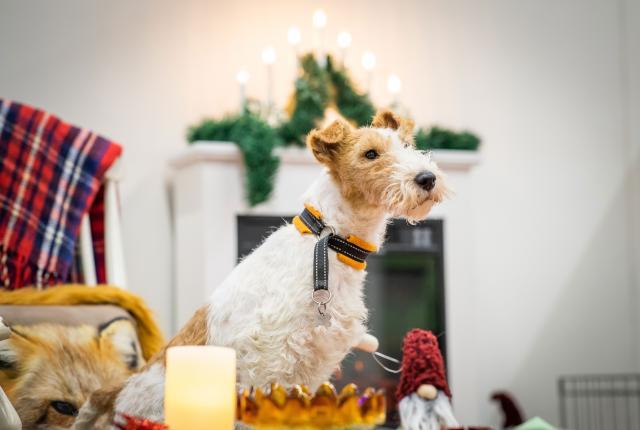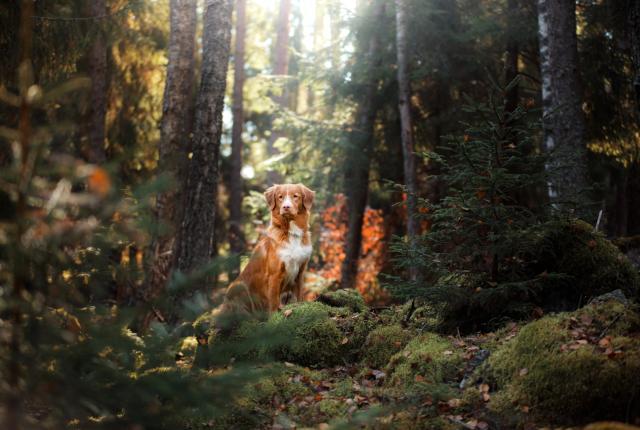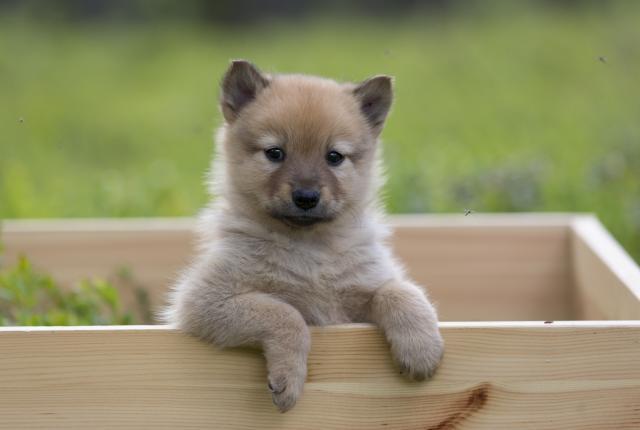For many, Christmas means time together with family and dogs. Dogs enjoy spending time together with you but do not long for Christmas treats or presents. Dogs may however be interested in tempting treats and ornaments that have appeared in the house. By observing a few important things, you can ensure a relaxed and safe Christmas for both your dog and the whole family.
We collected a check list for holidays together with the Finnish Kennel Club’s veterinarian Liisa Lilja-Maula.
Many would like to give their dog a taste of Christmas delicacies. However, many Christmas foods that are meant for people may be dangerous for dogs.
It is not a good idea to let your dog have Christmas ham due to the amount of salt and fat in it, not even if the dog sat patiently beside you by the oven waiting for the ham to cook. Cooking fat from the ham is harmful for dogs and can at worst cause pancreatitis. You should not give ham or poultry bones to your dog. Bones may block your dog’s bowels or sharp splinters of bone may even puncture the bowels. Make also sure that the dog does not get its paws on the ham net, since it could cause a life-threatening intestinal obstruction. Throw the ham net in the bin so that your dog does not get a hold of it.
Spicy Christmas foods and pastries that contain yeast may upset the dog’s stomach and are therefore not suitable for dogs. When it comes to sweet Christmas treats, dark chocolate is among the most dangerous ones. It is therefore a good idea to move away boxes of chocolates out of reach of the dog. The darker the chocolate, the more dangerous it is for dogs. Even a small amount of chocolate may cause serious poisoning. Contact a veterinarian if your dog suddenly becomes ill. The first signs of poisoning can be seen within the first 4–24 hours. Signs include vomiting, shaking, increased urination, stomach pains, and cramping.
Make sure that foods are not left in places where the dog is able to get to them. If you however notice that your dog has eaten forbidden things, contact your veterinarian. It is a good idea to check the contact information and opening hours for veterinarians on call in good time before the holidays.
Food items that are forbidden for dogs include:
- Christmas ham
- cooking fat from the ham
- sweets
- spicy foods
- doughs that contain yeast or baking soda
- chocolate (especially dark chocolate)
- macadamia nuts
- grapes and raisins
- xylitol
It is also a good idea to place candles and the Christmas tree so that the dog does not manage to tip them over bustling around. For example, compost net can be used to create borders around the tree. Especially young dogs may be interested in Christmas lights, so it is a good idea to hide electric wires out of reach of dogs.
Also pay attention to Christmas flowers. Traditional Christmas flowers, such as hellebore, poinsettia, amaryllis belladonna, azalea, tulips, and yew, are poisonous for dogs. Puppies are more boisterous than adult dogs and it is therefore worthwhile to keep an extra eye on their whereabouts to make sure that they do not get a taste of Christmas flowers. If your dog gets its paws on a poisonous Christmas flower, contact your veterinarian.
Suitable treats or chew bones for dogs can be found in pet stores. You can also offer your dog something to do by hiding its favourite treats or by playing a brain game with your dog, providing mental stimulation.
If you have gotten your dog his very own Christmas present, leave out all sorts of tape, string, and bags when wrapping the gift. You can wrap the gift in a way that is fun for the dog. For example, unwrapping a gift wrapped in paper towels can be amusing for the dog.
The gift does not necessarily have to be edible. A longer walk than usual or a trip to the forest make both the owner and the dog happy. Learning a new trick can also be a fun thing to do together. Your dog can also be treated with some extra scratches and by relaxing together.
There may be many unusual things for your dog to wonder at during Christmas. Make sure that there is a safe and familiar place for your dog to rest in among all hustle and bustle.
Let us enjoy a safe and peaceful Christmas and a pleasant time together with our dogs.




 Hau-Hau Champion
Hau-Hau Champion Agria
Agria